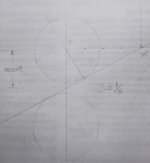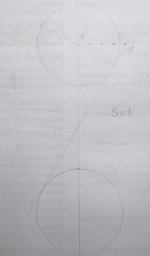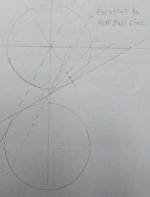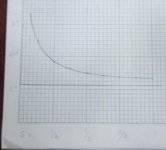Close balls, the changing object ball width and the cosecant function
If you've read the post about the secant, you may be interested in the part the cosecant plays as the separation between balls changes. The cosecant is the horizontal line segment from the center of the ball out to the tangent line. This line gives the effective width of the object ball. As the distance between the balls change, the OB 'shrinks' and 'expands' as a function of the cosecant.


On the first diagram notice the relationship between the secant line and the cosecant. When the balls are close, the secant line is short and the cosecant line is long. The second diagram shows as the separation increases the cosecant becomes smaller. At larger distances it becomes very small and plays no part in the aiming process.
The first diagram is about a 1/6 diameter separation with a MAX angle of 30*. The cosecant line is marked with 0* at the center and 30* at the intersection point of the tangent line. It encompasses all 30* of the available cut angles. It's been divided into four equal segments to represent the 'quarters' of the 'effective' OB. If the cue ball is aimed edge to edge down the tangent line, it's the same as aiming the edge at the endpoint of the cosecant line. In effect the OB is more than twice it's normal width. The second diagram with a one ball separation has a much smaller cosecant line. The OB has 'shrunk' due to the increased separation.

The third diagram shows a 'half ball' hit for two close balls. The left dashed line is drawn from the edge of the CB to the center of the OB. The right dashed line is a parallel shift moved so the line passes through the midpoint (MP) of the balls centers mentioned in the post about the secant. The actual contact point is far short of a half ball hit.
An equation can be used to find the effective OB width as a function of separation. Before I give the equation, I'll explain the reasoning behind it. The separation in ball diameters gives the Max angle by using the equation: MAX = asec (S+1). When the cosecant of that angle is found, it will give the length of the cosecant line. The length will be one ball radius plus an extra amount that will change as separation varies. The value is the ratio of the true radius and the effective radius. If this ratio is multiplied by the diameter, the effective 'size' of the OB can be found.
To find the 'growth' equation as a function of separation : MAX = asec (S+1) to get the angle of separation. S is in ball diameters.
The cosecant of that angle will give the length of the cosecant line : csc(MAX) = csc[asec (S+1)]. To find the effective 'size' of the OB, multiply this number by the ball diameter.
Multiply csc(MAX) by 100 to convert to percentage of 'growth': [csc (asec (S+1))] X 100 = % of growth
Two quick, extreme examples: S = 1/8 ball separation, and S = 20 (about half table)
S = 1/8: [csc(asec(1+.125))] = 2.18 : multiply by 2.25" = 4.91" effective size : or : multiply by 100 = 218% , more than double the size.
S = 20 : [csc(asec(1+20))] = 1.001 : X 2.25" = 2.252" effective size : or : X 100 = 100.1% , only one tenth of a percent larger.
Below is a separation vs. size graph that shows how fast the effective width falls from a separation of 1/16 to one ball. I scaled the graph to 'flatten' it and make it easier to read. The bottom scale is the ball separation and the vertical scale is in inches. The solid horizontal line is at 2.25 inches, the diameter of a ball. It could be neater but I got tired of f'n with the damn thing.

At S=1, the ball is 16% larger. It takes S=6 to get the size to within 1%. At S=9 it drops to 1/2%. At S=13 it's down to 1/4%. I was going to graph this out also but I'm sure you can see it falls much slower and becomes almost a straight line past S=9.
What's the point where the ball separation doesn't affect the aiming? I would hazard a guess that 1% would be good enough for short, open shots and that 1/2% should be fine for the entire table. What's your opinion on the matter?
If you've read the post about the secant, you may be interested in the part the cosecant plays as the separation between balls changes. The cosecant is the horizontal line segment from the center of the ball out to the tangent line. This line gives the effective width of the object ball. As the distance between the balls change, the OB 'shrinks' and 'expands' as a function of the cosecant.


On the first diagram notice the relationship between the secant line and the cosecant. When the balls are close, the secant line is short and the cosecant line is long. The second diagram shows as the separation increases the cosecant becomes smaller. At larger distances it becomes very small and plays no part in the aiming process.
The first diagram is about a 1/6 diameter separation with a MAX angle of 30*. The cosecant line is marked with 0* at the center and 30* at the intersection point of the tangent line. It encompasses all 30* of the available cut angles. It's been divided into four equal segments to represent the 'quarters' of the 'effective' OB. If the cue ball is aimed edge to edge down the tangent line, it's the same as aiming the edge at the endpoint of the cosecant line. In effect the OB is more than twice it's normal width. The second diagram with a one ball separation has a much smaller cosecant line. The OB has 'shrunk' due to the increased separation.

The third diagram shows a 'half ball' hit for two close balls. The left dashed line is drawn from the edge of the CB to the center of the OB. The right dashed line is a parallel shift moved so the line passes through the midpoint (MP) of the balls centers mentioned in the post about the secant. The actual contact point is far short of a half ball hit.
An equation can be used to find the effective OB width as a function of separation. Before I give the equation, I'll explain the reasoning behind it. The separation in ball diameters gives the Max angle by using the equation: MAX = asec (S+1). When the cosecant of that angle is found, it will give the length of the cosecant line. The length will be one ball radius plus an extra amount that will change as separation varies. The value is the ratio of the true radius and the effective radius. If this ratio is multiplied by the diameter, the effective 'size' of the OB can be found.
To find the 'growth' equation as a function of separation : MAX = asec (S+1) to get the angle of separation. S is in ball diameters.
The cosecant of that angle will give the length of the cosecant line : csc(MAX) = csc[asec (S+1)]. To find the effective 'size' of the OB, multiply this number by the ball diameter.
Multiply csc(MAX) by 100 to convert to percentage of 'growth': [csc (asec (S+1))] X 100 = % of growth
Two quick, extreme examples: S = 1/8 ball separation, and S = 20 (about half table)
S = 1/8: [csc(asec(1+.125))] = 2.18 : multiply by 2.25" = 4.91" effective size : or : multiply by 100 = 218% , more than double the size.
S = 20 : [csc(asec(1+20))] = 1.001 : X 2.25" = 2.252" effective size : or : X 100 = 100.1% , only one tenth of a percent larger.
Below is a separation vs. size graph that shows how fast the effective width falls from a separation of 1/16 to one ball. I scaled the graph to 'flatten' it and make it easier to read. The bottom scale is the ball separation and the vertical scale is in inches. The solid horizontal line is at 2.25 inches, the diameter of a ball. It could be neater but I got tired of f'n with the damn thing.

At S=1, the ball is 16% larger. It takes S=6 to get the size to within 1%. At S=9 it drops to 1/2%. At S=13 it's down to 1/4%. I was going to graph this out also but I'm sure you can see it falls much slower and becomes almost a straight line past S=9.
What's the point where the ball separation doesn't affect the aiming? I would hazard a guess that 1% would be good enough for short, open shots and that 1/2% should be fine for the entire table. What's your opinion on the matter?